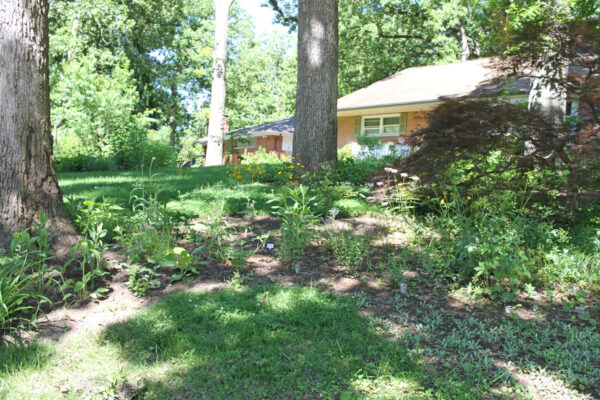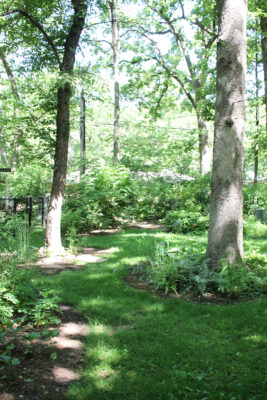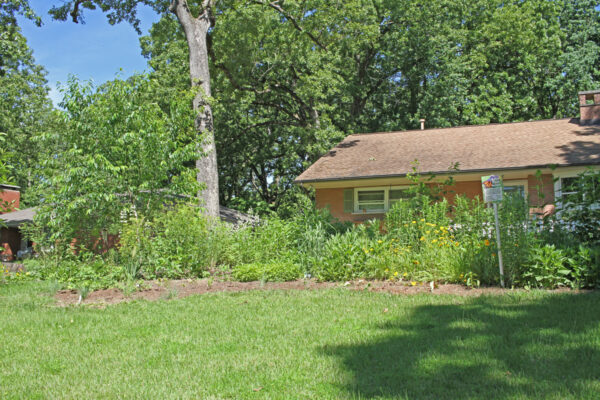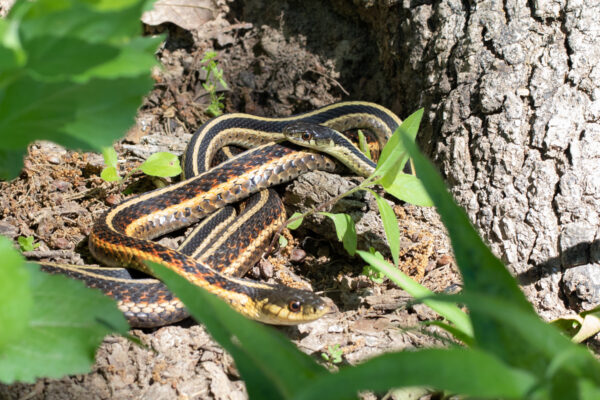by Savannah Furhman
St. Louis Chapter member and Virtually Wild! Contributor
Susan & Ed Rohde are fairly recent native plant enthusiasts, the removal of bush honeysuckle being the prompter. They moved into their home in 2011 and the yard looked OK, a typically well-manicured suburban landscape. There was a messy but tolerable bush honeysuckle privacy hedge across their back yard.
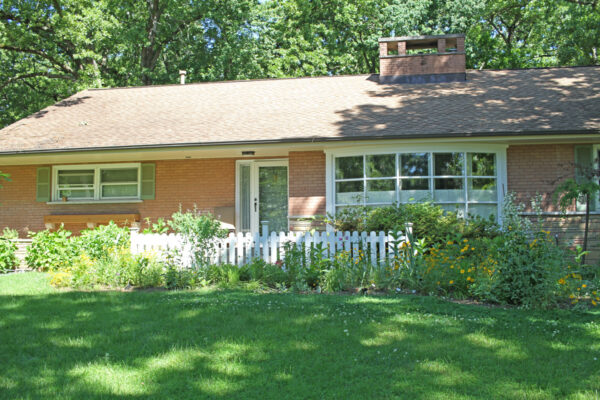 Over time they learned it was an invasive plant and realized it had to come out. Deciding what to use to replace it led Susan to research plants, during which time she learned about benefits of native plants. In 2016 on the Sustainable Backyard Tour Susan visited the garden of Sue Leahy, who introduced her to Wild Ones. Liking the concept, they donated to the organization and, as a result, became members. One of their daughters gave Susan a catalog from Missouri Wildflowers Nursery (which we all know and love) assuring them plants they might purchase were native to Missouri. This was a big turning point.
Over time they learned it was an invasive plant and realized it had to come out. Deciding what to use to replace it led Susan to research plants, during which time she learned about benefits of native plants. In 2016 on the Sustainable Backyard Tour Susan visited the garden of Sue Leahy, who introduced her to Wild Ones. Liking the concept, they donated to the organization and, as a result, became members. One of their daughters gave Susan a catalog from Missouri Wildflowers Nursery (which we all know and love) assuring them plants they might purchase were native to Missouri. This was a big turning point.
Being novices, they experimented with a variety of plants to identify the best honeysuckle replacement. They bought fragrant sumac, silky dogwood, spicebush, chokeberry, and witch hazel, —all of which are thriving. Later additions to their shady woodland backyard included elderberry, Carolina buckthorn, mock orange, coral berry, wild hydrangea, and palm sedge.
In their back yard, over time, they removed burning bush, English Ivy, wintercreeper, and butterfly bush, replacing them with serviceberries, dogwoods, beautyberries, ferns, sedges, celandine poppies, and columbines. This year the poppies were spectacular, blooming profusely this past April. Susan commented that it was like being in a conservation area or, to use the words of Doug Tallamy, their own Homegrown National Park. Besides removing the invasive non-native plants, over the years they removed and continue to remove many hostas, day lilies, ornamental grasses, boxwoods, and a crape myrtle. While they are not problem plants, they take up too much valuable space for what little wildlife benefit they offer.
St. Louis Audubon Society’s Bring Conservation Home program, St. Louis Community College classes, Partners for Native Landscaping, and Wild Ones have been valuable sources of information on the value of growing natives. Susan and Ed became enthusiastic devotees. Susan says, “You know how they tell you to start small and be successful in one area before you move to another, well, we didn’t do that.”
Motivated by their dawning vision, they continued to reshape their yard. Ed was able to clear faster than Susan could plant, but as a result they now have a bigger garden. They look forward to planting more trees, and also to creating layers as their yard has mature trees, but few understory trees and shrubs.
Their sunny front yard is the full sun, prairie garden area. Susan especially likes the queen of the prairie because, though it’s tall, no stakes are required, and it doesn’t flop even after a storm. Starting from seed, Susan ended up with one partridge pea plant, but it has done well, spreading and sharing the bed with many species, with prairie pussy toes as a green mulch. Lanceleaf coreopsis was a favorite, but they have learned it readily spreads and tends to flop. Other plants include wild blue indigo (blooming for the first time after 4 years), purple poppy mallow, Indian pinks, Pennsylvania sedge, and fragrant sumac. Susan says, “We just buy plants we like and want to try out. We’ll figure out where to plant them later on.” They relish the wonder that they have so many plants they love, plants that they knew nothing about a few years ago!
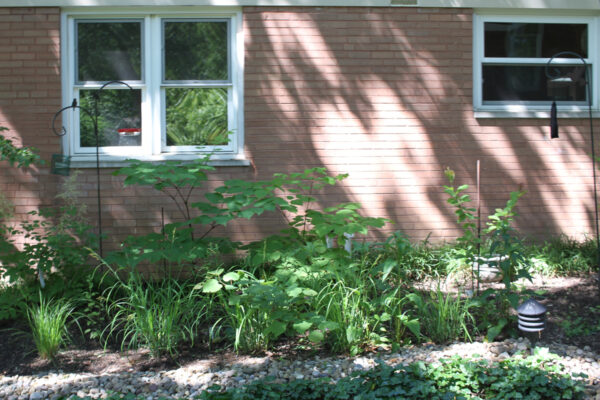 Creating native landscape has not been without challenges. Their yard had been landscaped extensively with thick landscaping fabric and rock. Planting meant first removing those barriers, and underneath there was the St. Louis clay. Some places, Susan speculates, were ¾ rock and ¼ clay, a challenge by anyone’s standard especially in a shady area! But wild petunias have done well. The pandemic has affected plant purchases. Susan realized that this is the first year they haven’t bought a single plant, but having their native gardens to focus on has given respite from the pandemic’s restrictions.
Creating native landscape has not been without challenges. Their yard had been landscaped extensively with thick landscaping fabric and rock. Planting meant first removing those barriers, and underneath there was the St. Louis clay. Some places, Susan speculates, were ¾ rock and ¼ clay, a challenge by anyone’s standard especially in a shady area! But wild petunias have done well. The pandemic has affected plant purchases. Susan realized that this is the first year they haven’t bought a single plant, but having their native gardens to focus on has given respite from the pandemic’s restrictions.
Hesitant to introduce native landscaping into a traditionally landscaped neighborhood, the Rohdes put up a sign indicating the natural habitat of their prairie garden. A pleasant surprise has been the favorable comments and questions that have occurred. The prairie garden has spurred connections with neighbors that might not otherwise have occurred. “It’s amazing what one yard can do.”
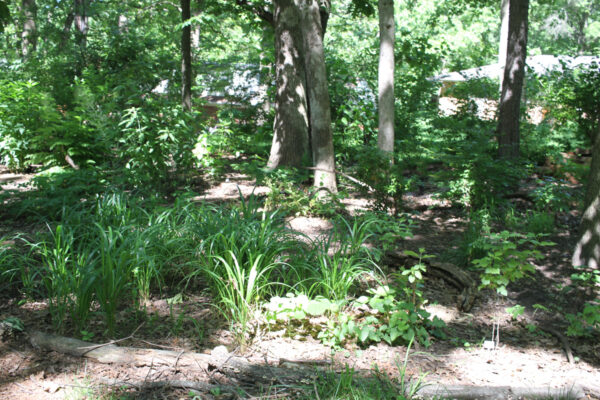 During the 5 years since honeysuckle opened their door to native plants, the Rohdes have undergone a total conversion to native plant appreciation. It was a surprise to Susan when she realized that landscaped yards now look artificial and staged to her. And, of course, they provide very little for the wildlife. The increase in beneficial insects in their yard as a result of their native plant efforts is noticeable. Today their sense of beauty and value is sparked by seeing blooming wild plants. And seeing the arrival of native plants in the spring is like welcoming back beloved friends. It is a gift to walk among the plants, welcoming each one as it blooms, to marvel at the growth, and to look for bees, insects and caterpillars on them. In addition, more butterflies visit their yard, and the bird population has increased, even bluebirds have shown up! American Goldfinches eat the purple coneflower and coreopsis seeds and last winter, birds were on the eastern blazing star, eating the seeds during a snowfall.
During the 5 years since honeysuckle opened their door to native plants, the Rohdes have undergone a total conversion to native plant appreciation. It was a surprise to Susan when she realized that landscaped yards now look artificial and staged to her. And, of course, they provide very little for the wildlife. The increase in beneficial insects in their yard as a result of their native plant efforts is noticeable. Today their sense of beauty and value is sparked by seeing blooming wild plants. And seeing the arrival of native plants in the spring is like welcoming back beloved friends. It is a gift to walk among the plants, welcoming each one as it blooms, to marvel at the growth, and to look for bees, insects and caterpillars on them. In addition, more butterflies visit their yard, and the bird population has increased, even bluebirds have shown up! American Goldfinches eat the purple coneflower and coreopsis seeds and last winter, birds were on the eastern blazing star, eating the seeds during a snowfall.
Susan said, “I had never seen such fascinating sights before we planted natives. We have seen more woodpeckers, too. We have recently begun to see a few toads and frogs, and even a snake now and then. So cool.”
Using native plants to better the world has led them to know and appreciate the various native organizations, particularly the Wild Ones, who are the epitome of helpfulness. Susan says it is refreshing to be among people so excited about native plants, and so willing to share information.

